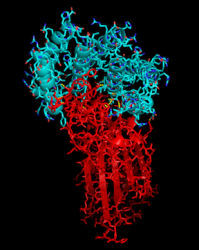
CIAFF-UAM has been running clients of the Rosetta@Home collaborative computational project in part of its CPU nodes since March the 30th. These nodes are normally used by ATLAS UAM local researchers to analyse particle physics data and by Nuclear Physics local researchers for theoretical simulations of nuclear structure. Now they have been reconfigured to study the proteins important to the COVID-19 disease, caused by the SARS-CoV-2 corona virus, as part of the Rosetta@Home worldwide network.
The Rosetta@Home project uses computer simulations to predict the structure of proteins important to the COVID-19 disease as well as to produce new, stable mini-proteins to be used as potential therapeutics and diagnostics of the COVID-19 diseases. Since the release of the SARS-CoV-2 genome sequences in late January, a number of important corona virus proteins have been modelled on Rosetta@Home volunteer computers.
Initially CIAFF has provided 11 computers with a total of 440 CPU cores for the Rosetta@Home project in a opportunistic use. The system managing the share of tasks is BOINC, developed at the University of Berkeley, which we have already utilised for the ATLAS experiment simulations since 2018. We are also considering to provide part of the Tier-2 resources of the ATLAS experiment for the Folding@Home project, complementary to the Rosetta@Home research on COVID-19, as an effort, coordinated by CERN, to dedicate part of the world-wide LHC data processing infrastructure to COVID-19 research boosting Folding@Home computing capacity.
